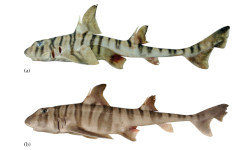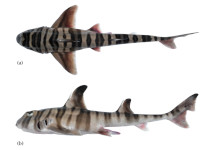Heterodontus marshallae
White, Mollen, O’Neill, Yang & Naylor, 2023
Classification: Elasmobranchii Heterodontiformes Heterodontidae
Reference of the original description
Species in Disguise: A New Species of Hornshark from Northern Australia (Heterodontiformes: Heterodontidae). Diversity, 15(7), Article 849
Species in Disguise: A New Species of Hornshark from Northern Australia (Heterodontiformes: Heterodontidae). Diversity, 15(7), Article 849
Types
Heterodontus marshallae
Holotype: WAM: P.35408-007; Paratype: CSIRO: CA 3286; CSIRO: H 6581–01; NTM: S.12929-001; NTM: S.18275-001; WAM: P.26193-010; WAM: P.30424-001;
Heterodontus marshallae
Holotype: WAM: P.35408-007; Paratype: CSIRO: CA 3286; CSIRO: H 6581–01; NTM: S.12929-001; NTM: S.18275-001; WAM: P.26193-010; WAM: P.30424-001;
Description :
Citation: Heterodontus marshallae White, Mollen, O’Neill, Yang & Naylor, 2023: In: Database of modern sharks, rays and chimaeras, www.shark-references.com, World Wide Web electronic publication, Version 12/2025
Please send your images of "Heterodontus marshallae" to info@shark-references.com

Heterodontus marshallae White, Mollen, O’Neill, Yang & Naylor, 2023, holotype, WAM P.35408-007, adolescent male, 541 mm TL, fresh: (a) dorsal view; (b) lateral view © White et al. 2023

Heterodontus marshallae White, Mollen, O’Neill, Yang & Naylor, 2023, holotype, WAM P.35408-007, adolescent male, 541 mm TL, fresh: (a) dorsal view; (b) lateral view © White et al. 2023
Common names
 Marshall's hornshark
Marshall's hornshark
 Marshall's hornshark
Marshall's hornshark
Short Description
Original diagnosis of White, Mollen, O’Neill, Yang & Naylor, 2023 [31915]: A small species of hornshark with the following combination of characters: colour pattern consisting of 22 dark bands and saddles; snout with a semicircular dark bar, usually bifurcated for most of its length; no dark bar below posterior gill slits extending onto anterior pectoral fin; anal fin well separated from caudal fin (anal-caudal space 11.0–13.5% TL); ventral lobe of caudal fin prominent (lower postventral margin 4.7–6.1% TL); dorsal spines long (exposed first dorsal spine length 3.9–4.5% TL); dorsal fins taller in juveniles than adults; symphyseal and anterior teeth pointed, lateral teeth molariform with a longitudinal keel; 20–22 tooth files in upper jaw, 17–19 in lower jaw; total vertebral centra 106–112, precaudal centra 70–76, monospondylous centra 33–37; egg case with narrow, curved, screw-like keels with 1.5 rotations from anterior to posterior margins.
Original diagnosis of White, Mollen, O’Neill, Yang & Naylor, 2023 [31915]: A small species of hornshark with the following combination of characters: colour pattern consisting of 22 dark bands and saddles; snout with a semicircular dark bar, usually bifurcated for most of its length; no dark bar below posterior gill slits extending onto anterior pectoral fin; anal fin well separated from caudal fin (anal-caudal space 11.0–13.5% TL); ventral lobe of caudal fin prominent (lower postventral margin 4.7–6.1% TL); dorsal spines long (exposed first dorsal spine length 3.9–4.5% TL); dorsal fins taller in juveniles than adults; symphyseal and anterior teeth pointed, lateral teeth molariform with a longitudinal keel; 20–22 tooth files in upper jaw, 17–19 in lower jaw; total vertebral centra 106–112, precaudal centra 70–76, monospondylous centra 33–37; egg case with narrow, curved, screw-like keels with 1.5 rotations from anterior to posterior margins.
Distribution
northern Australia from west of Exmouth Peninsula east to at least off Bathurst Island in the Northern Territory [31915]
northern Australia from west of Exmouth Peninsula east to at least off Bathurst Island in the Northern Territory [31915]
Dentition
Dental formula (based on paratype CSIRO H 6581-01 from left to right, in upper jaw 4L–3AL–3A–1S–3A–2AL–4L (20 tooth files in total) and lower jaw 4L–1AL–3A– 1S–3A–1AL–4L (17 tooth files in total). Holotype with about 22 files in upper jaw and 19 files in lower jaw; counts difficult to confirm on digital radiographs where jaws overlap. Strong monognathic heterodonty, including clutching and grinding type dentitions (sensu Cappetta [70]). Symphyseal and anterior teeth pointed, consisting of a principal cusp, flanked by one, or sometimes two pairs of cusplets that are hardly individualised. Lateral teeth molariform, lanceolate shaped, relatively broad but not extremely elongated, and with a longitudinal keel. Labial and lingual crown ornamentation present, showing a texture of transverse ridges running perpendicular to keel. Antero-laterals with intermediate tooth morphology. Dignathic heterodonty weak, with a higher number of antero-lateral teeth in the upper jaws, resulting in more upper tooth files compared to lower jaws. In contrast to lower posterior most tooth file, the upper file is much smaller and mesio-distally compressed compared to adjacent files. Ontogenetic dental shifts present and characterized transformation from clutching to grinding type dentition in lateral tooth positions during early maturity stages. The presence of sexual dimorphism was not examined. [31915]
Dental formula (based on paratype CSIRO H 6581-01 from left to right, in upper jaw 4L–3AL–3A–1S–3A–2AL–4L (20 tooth files in total) and lower jaw 4L–1AL–3A– 1S–3A–1AL–4L (17 tooth files in total). Holotype with about 22 files in upper jaw and 19 files in lower jaw; counts difficult to confirm on digital radiographs where jaws overlap. Strong monognathic heterodonty, including clutching and grinding type dentitions (sensu Cappetta [70]). Symphyseal and anterior teeth pointed, consisting of a principal cusp, flanked by one, or sometimes two pairs of cusplets that are hardly individualised. Lateral teeth molariform, lanceolate shaped, relatively broad but not extremely elongated, and with a longitudinal keel. Labial and lingual crown ornamentation present, showing a texture of transverse ridges running perpendicular to keel. Antero-laterals with intermediate tooth morphology. Dignathic heterodonty weak, with a higher number of antero-lateral teeth in the upper jaws, resulting in more upper tooth files compared to lower jaws. In contrast to lower posterior most tooth file, the upper file is much smaller and mesio-distally compressed compared to adjacent files. Ontogenetic dental shifts present and characterized transformation from clutching to grinding type dentition in lateral tooth positions during early maturity stages. The presence of sexual dimorphism was not examined. [31915]
Remarks
shark-references Species-ID=16502;
shark-references Species-ID=16502;


















